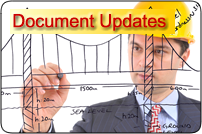
Today’s Guest Post is by Nathan B. Hinch, an associate at Mueller & Reece, LLC in Bloomington, Illinois, concentrating in the practice of commercial, construction, environmental, and real estate law. He can be reached at nhinch@muellerreece.com and on twitter @NathanHinch.
Form Construction Contracts – How Do They Compare, and How Should They Be Used?
By Nathan B. Hinch
Imagine that you are a contractor from the mythical State of Verbalville, a land where the handshake deal is the norm and no one ever puts anything in writing. If a developer/owner awarded you a project and asked you to sign an AIA Document A101™ form construction contract, along with AIA Document A201™ General Conditions, would you sign it without reading the document? Of course not. Assuming that you were willing to consider bucking the verbal trend and sign the document at all, you would likely read it over very carefully first. You might also consult an attorney, to help you understand the potential risks and liability issues involved with the contract, including the enforceability of the contract under Verbalville State law, and suggest changes to the document.
Now imagine that you are a contractor in my home State of Illinois and are awarded a project in North Carolina. If the developer/owner handed you a ConsensusDOCS® 200 form construction contract with general conditions and asked you to sign, would you do so without reading it? Would you consult a professional attorney before signing? What if you were familiar with the form documents from your work in Illinois? Would it matter if it was an EJCDC document instead?
I have worked with AIA, ConsensusDOCS®, and EJCDC form documents, and all three are excellent resources that in the right hands can help save time and money for construction projects. But here’s the point – form contracts are wonderful tools that can help allocate risk and clarify the roles and responsibilities of the parties, but that is all they are.
In the construction field, the leading form contracts have been drafted by teams of experts representing the interest groups in general and supporting teams of attorneys. If you have never used or read one of these before, I would encourage you to take an evening and read through at least one of those mentioned above. Given the detail of the documents, it may be difficult to imagine that these forms, without editing, are likely not specific enough for your project. But keep in mind as you read that these are national forms and are meant to be of use throughout the U.S. By definition these forms do not generally consider 1) variations in State law requirements and 2) your particular project needs or goals. For that reason, credible forms such as those produced by AIA, ConsensusDOCS®, or EJCDC will encourage users to consult an attorney before using the document for specific projects. They are not meant for “plug and play” use.
For a great reference comparing these forms, see Gillies, Heckman, and Perlberg, THE Construction Contracts Book: How to Find Common Ground in Negotiating Design and Construction Clauses, American Bar Association 2008. The EJCDC and ConsensusDOCS websites both provide a matrix from this book for PDF download. The book may be purchased from the ABA website here.
[Ed note: I second Nathan’s book recommendation, which is a great resource for anyone considering the pros and cons of each set of form documents.]
Nathan and I look forward to answering your comments, thoughts, and questions. Drop us a note!




